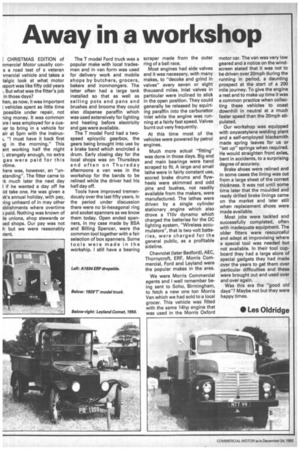Away in a workshop
Page 16

If you've noticed an error in this article please click here to report it so we can fix it.
CHRISTMAS EDITION of nmercial Motor usually cons a road test of a veteran imercial vehicle and takes a talgic look at what motor 'sport was like fifty odd years . But what was the fitter's job in those days?
hen, as now, it was important ( vehicles spent as little time possible under repair, not ling money. It was common ?re I was employed for a cusler to bring in a vehicle for air at 5pm with the instruc1, "I must have it back first ig in the morning." This ant working half the night I, strangely enough, no extra ges were paid for this Ttime.
here was, however, an "unstanding". The fitter came to -k much later the next day I if he wanted a day off he Id take one. He was given a .k's annual holiday, with pay, ling unheard of in may other ablishments where overtime 3 paid. Nothing was known of le unions, shop stewards or 3ed shops. Our pay was not h but we were reasonably itent.
The T model Ford truck was a popular make with local tradesmen and in van form was used for delivery work and mobile shops by butchers, grocers, bakers and ironmongers. The latter often had a large tank installed so that as well as selling pots and pans and brushes and brooms they could also dispense paraffin which was used extensively for lighting and heating before electricity and gas were available.
The T model Ford had a twospeed epicyclic gearbox, the gears being brought into use by a brake band which encircled a drum. Early closing day for the local shops was on Thursdays and often on Thursday afternoons a van was in the workshop for the bands to be relined while the driver had his half day off.
Tools have improved tremendously over the last fifty years. In the period under discussion there were no bi-hexagonal ring and socket spanners as we know them today. Open ended spanners, in my case made by BSA and Billing Spencer, were the common tool together with a fair selection of box spanners. Some tools were made in the workship. I still have a bearing scraper made from the outer ring of a ball race.
Most engines had side valves and it was necessary, with many makes, to "decoke and grind in valves" every seven or eight thousand miles. Inlet valves in particular were inclined to stick in the open position. They could generally be released by squirting paraffin into the carburettor inlet while the engine was running at a fairly fast speed. Valves burnt out very frequently.
At this time most of the vehicles were powered by petrol engines.
Much more actual "fitting" was done in those days. Big end and main bearings were hand scraped to fit. A large and small lathe were in fairly constant use, scored brake drums and flywheels were skimmed and odd pins and bushes, not readily available from the makers, were manufactured. The lathes were driven by a single cylinder stationary engine which also drove a 110v dynamo which charged the batteries for the DC lighting system. "Wireless accumulators", that is two volt batteries, were charged for the general public, as a profitable sideline.
Chevrolet (later Bedford), AEC, Thornycroft, ERF, Morris Commercial, Ford and Leyland were the popular makes in the area.
We were Morris Commercial agents and I well remember being sent to Soho, Birmingham, to fetch a new one ton Morris Van which we had sold to a local grocer. This vehicle was fitted with the same 14hp engine that was used in the Morris Oxford motor car. The van was very low geared and a notice on the windscreen stated that it was not to be driven over 20mph during the running in period, a daunting prospect at the start of a 200 mile journey. To give the engine a rest and to make up time it was a common practice when collecting these vehicles to coast downhill in neutral at a much faster speed than the 20mph stipulated.
Our workshop was equipped with oxyacetylene welding plant and a self-employed blacksmith made spring leaves for us or "set up" springs when required. He would straighten front axles, bent in accidents, to a surprising degree of accuracy.
Brake shoes were relined and in some cases the lining was cut from a large sheet of the correct thickness. It was not until some time later that the moulded and ready drilled brake linings came on the market and later still when replacement shoes were made available.
Most jobs were tackled and successfully completed, often with inadequate equipment. The older fitters were resourceful and adept at improvising where a special tool was needed but not available. In their tool cupboard they had a large store of special gadgets they had made over the years to get them over particular difficulties and these were brought out and used over and over again.
Was this era the "good old days"? Maybe not but they were happy times.
• Les Oldridge




















































